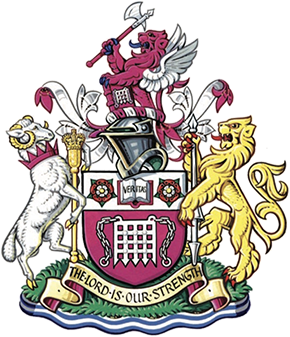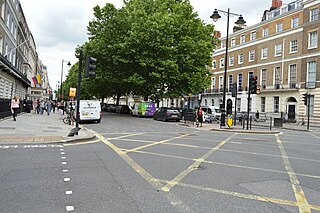
Quintin Hogg was an English philanthropist, remembered primarily as a benefactor of the Royal Polytechnic institution at Regent Street, London, now the University of Westminster.

The University of Westminster is a public university based in London, United Kingdom. Founded in 1838 as the Royal Polytechnic Institution, it was the first polytechnic to open in London. The Polytechnic formally received a Royal charter in August 1839, and became the University of Westminster in 1992.

The Polytechnic Stadium is a sports venue on Hartington Road, Chiswick, London. It is the centre piece of the Quintin Hogg Memorial Grounds.

Portland Place is a street in the Marylebone district of central London. Named after the 3rd Duke of Portland, the unusually wide street is home to the BBC's headquarters Broadcasting House, the Chinese and Polish embassies, the Royal Institute of British Architects and numerous residential mansion blocks.

The statue of George V in Old Palace Yard, Westminster, London, is a sculpture of George V, King of the United Kingdom and the British Dominions, and Emperor of India. The statue was sculpted prior to the Second World War and was hidden in a quarry during the war years. Other locations were suggested for the statue, including Parliament Square, but it was unveiled opposite the House of Lords in 1947.

The Guards Memorial, also known as the Guards Division War Memorial, is an outdoor war memorial located on the west side of Horse Guards Road, opposite Horse Guards Parade in London, United Kingdom. It commemorates the war dead from the Guards Division and related units during the First World War, and of the Household Division in the Second World War and other conflicts since 1918.

The statue of the Earl Kitchener is an outdoor bronze statue by John Tweed depicting Herbert Kitchener, 1st Earl Kitchener, installed in 1926 and located on the south side of Horse Guards Parade in London, United Kingdom. The sculpture stands on a Portland stone plinth. It became a Grade II listed building in 1970.

The Imperial Camel Corps Memorial is an outdoor sculpture commemorating the Imperial Camel Corps, located in Victoria Embankment Gardens, on the Thames Embankment to the east of Charing Cross station, in London, England. The unit of mounted infantry was created in December 1916 from troops that had served in the Gallipoli campaign in the Dardanelles.

A Grade II-listed bronze statue of Robert Clive, 1st Baron Clive, by John Tweed, stands in King Charles Street, Whitehall, London. The work was unveiled in 1912 outside Gwydyr House, also in Whitehall, and was moved to its current location in 1916.

A Grade I-listed statue of Queen Anne stands on a pedestal alongside the north wall of No. 15 Queen Anne's Gate in Westminster, London. It portrays the queen wearing a brocaded skirt and bodice and an open cloak with the insignia of the Order of the Garter; on her head is a small crown and in her hands she holds an orb and sceptre. The statue, carved from Portland stone, stands on a plinth of the same material with the inscription ANNA REGINA. The pedestal consists of a fat "engaged" cylinder with a flat volute on either side, each with scrolls adorned with carved flowers and leaves. Neither the sculptor's identity nor the exact date of the work are known, but it is probably of the early eighteenth century.

A statue of Edward Jenner, the physician, scientist and pioneer of the world's first vaccine, is located in Kensington Gardens in London. A work of the sculptor William Calder Marshall, the bronze was originally unveiled by Albert, Prince Consort in Trafalgar Square on 17 May 1858, before being moved to its present location in 1862. It is a Grade II listed building.

A bronze statue of Admiral of the Fleet Louis Mountbatten, 1st Earl Mountbatten of Burma is located on Mountbatten Green, off Horse Guards Road, Whitehall, London, England. The sculptor was Franta Belsky and the work was cast by the Meridian Bronze Foundry. The memorial was unveiled on 2 November 1983.

The South Bank Lion is an 1837 sculpture in Central London. Since 1966 it has stood next to County Hall, on the South Bank of the River Thames. It is a significant depiction of a lion, along with the four that surround Nelson's Column in Trafalgar Square just across the river.
Ethel Mary Wood CBE was an advertising executive, feminist campaigner, philanthropist, bible collector, and the daughter of Quintin Hogg, a businessman and philanthropist who established the Regent Street Polytechnic, the largest London-based adult education provider of its day. Wood inherited her father’s strong religious convictions and philanthropy, serving with the London War Pensions Committee, the Winter Distress League, various women’s organisations, and as governor of her father’s Polytechnic.

The Emmeline and Christabel Pankhurst Memorial is a memorial in London to Emmeline Pankhurst and her daughter Christabel, two of the foremost British suffragettes. It stands at the entrance to Victoria Tower Gardens, south of Victoria Tower at the southwest corner of the Palace of Westminster. Its main feature is a bronze statue of Emmeline Pankhurst by Arthur George Walker, unveiled in 1930. In 1958 the statue was relocated to its current site and the bronze reliefs commemorating Christabel Pankhurst were added.

The Civil Service Rifles War Memorial is a First World War memorial located on the riverside terrace at Somerset House in central London, England. Designed by Sir Edwin Lutyens and unveiled in 1924, the memorial commemorates the 1,240 members of the Prince of Wales' Own Civil Service Rifles regiment who were killed in the First World War. They were Territorial Force reservists, drawn largely from the British Civil Service, which at that time had many staff based at Somerset House.

The Royal Artillery Boer War Memorial is located on the south side of The Mall in Central London, close to the junction with Horse Guards Road at the northeast corner of St James's Park. Unveiled in 1910, it marks the deaths of the 1,083 soldiers of the Royal Artillery who died in the Second Boer War from 1899 to 1902 It has been a listed building since 1970.

The equestrian statue of Ferdinand Foch stands in Lower Grosvenor Gardens, London. The sculptor was Georges Malissard and the statue is a replica of another raised in Cassel, France. Foch, appointed Supreme Commander of the Allied Forces on the Western Front in the Spring of 1918, was widely seen as the architect of Germany's ultimate defeat and surrender in November 1918. Among many other honours, he was made an honorary Field marshal in the British Army, the only French military commander to receive such a distinction. Following Foch's death in March 1929, a campaign was launched to erect a statue in London in his memory. The Foch Memorial Committee chose Malissard as the sculptor, who produced a replica of his 1928 statue of Foch at Cassel. The statue was unveiled by the Prince of Wales on 5 June 1930. Designated a Grade II listed structure in 1958, the statue's status was raised to Grade II* in 2016.

A bronze statue of Robert Stephenson by Carlo Marochetti usually stands on a red granite plinth in the forecourt of Euston railway station in London, England. Erected in 1871, it is one of few surviving elements of the original station after it was redeveloped in the 1960s, and it became a Grade II listed building in 1974. It was temporarily removed in 2020 to allow the station to be remodelled to accommodate the new High Speed 2 (HS2) railway line.

The Gladstone Memorial on the Strand, London is a bronze sculpture of the British statesman, created by Hamo Thornycroft between 1899-1905. The statue was erected as the national memorial to Gladstone and shows him in the robes of the Chancellor of the Exchequer. The figure stands on a plinth surrounded by allegorical figures depicting four of the Virtues, Courage, Brotherhood, Education and Aspiration. The memorial is a Grade II listed structure.




















